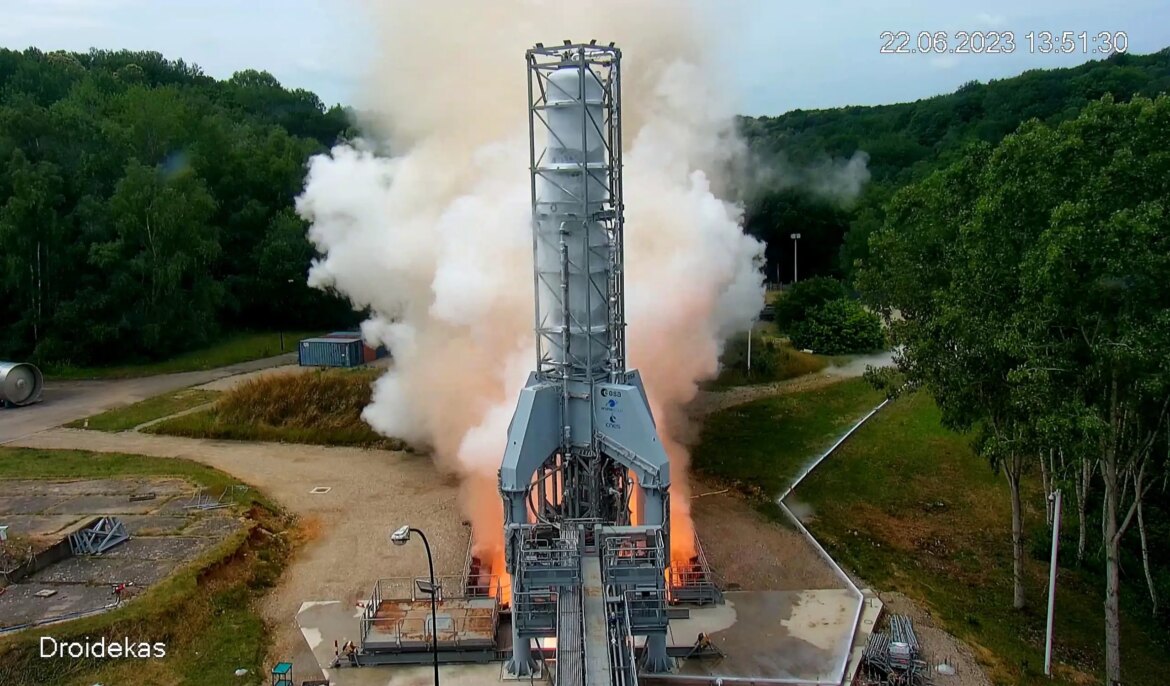A major breakthrough in the advancement of reusable rockets has been achieved by ArianeGroup, as they successfully conducted a test of the Prometheus engine at their facility in Vernon, France on June 22, 2023. This cutting-edge engine, boasting a thrust capacity of 100 tonnes, incorporates groundbreaking materials and manufacturing techniques such as 3D printing, resulting in a remarkable reduction in costs compared to its predecessor, the Vulcain 2 engine used in Ariane 5. The Prometheus engine operates on a highly efficient combination of liquid oxygen and liquid methane fuel, simplifying handling procedures and greatly enhancing reusability.
In a significant stride towards the development of reusable European rockets, ArianeGroup has demonstrated the Prometheus engine’s potential. This engine, belonging to the 100-tonne thrust class, harnesses the power of liquid oxygen and liquid methane fuel, while leveraging the advantages of 3D printing to achieve cost-effectiveness, cleanliness, and reusability. The engine is now mounted on a prototype reusable rocket stage named Themis, and further comprehensive tests will be conducted to evaluate its flight and landing capabilities. The Prometheus engine is expected to play a central role in the future generation of European launchers.
Continuing their efforts to create reusable engines for European rockets, ArianeGroup has achieved a significant milestone with the full ignition of the early Prometheus prototype. Captured on June 22, 2023, at ArianeGroup’s test facility in Vernon, France, these images showcase a 12-second burn that signifies a crucial step forward in space exploration.
The Prometheus engine, belonging to the 100-tonne thrust class, employs a range of advanced materials and manufacturing techniques that significantly reduce costs compared to its predecessor, the Vulcain 2 engine found in Ariane 5. The liquid oxygen and liquid methane fuel used in the Prometheus engine provide cleaner combustion and simplify handling procedures, thereby enabling reusability and reducing ground operation expenses before and after each flight.
Notable features of the Prometheus engine include its variable thrust capacity and multiple ignition capabilities. Leveraging the power of additive layer manufacturing, also known as 3D printing, the engine benefits from reduced part count, accelerated production, and minimized waste.
During the tests conducted in Vernon and Lampoldshausen, the Prometheus engine was mounted on a prototype of a reusable rocket stage named Themis, which is concurrently being developed alongside the engine. This engine-stage combination will undergo a series of “hop-tests,” involving short-distance ascents above ground level, to thoroughly evaluate its flight and landing capabilities.
Prometheus and Themis together represent the foundational components of a future family of European launchers, as envisioned by ArianeGroup. These remarkable technological advancements in reusable rocketry pave the way for an exciting future in space travel.
Table of Contents
Frequently Asked Questions (FAQs) about Reusable rockets
What is the Prometheus engine and how does it contribute to the future of space travel?
The Prometheus engine is a 100-tonne thrust class engine developed by ArianeGroup. It utilizes innovative materials and manufacturing techniques like 3D printing and operates on a clean-burning fuel combination of liquid oxygen and liquid methane. The engine’s cost-effective design and enhanced reusability make it a crucial element in advancing European launchers and the future of space travel.
How does the Prometheus engine reduce costs compared to its predecessor, the Vulcain 2?
The Prometheus engine incorporates cost-saving measures through the extensive use of 3D printing, which reduces the number of parts, speeds up production, and minimizes waste. These advancements allow the engine to achieve a cost reduction of approximately one-tenth compared to the Vulcain 2 engine used in Ariane 5, making it more economically viable for space missions.
What are the advantages of using liquid oxygen-liquid methane fuel in the Prometheus engine?
By utilizing liquid oxygen-liquid methane fuel, the Prometheus engine offers several advantages. Methane is a clean-burning fuel, reducing environmental impact and simplifying handling procedures. This fuel combination enhances the engine’s reusability and helps reduce the cost of ground operations before and after each flight, making it a more efficient and sustainable option for space travel.
How does the Prometheus engine contribute to the development of reusable rockets?
The Prometheus engine, mounted on a reusable rocket stage prototype called Themis, plays a significant role in the advancement of reusable rockets. By incorporating state-of-the-art technologies like 3D printing and utilizing clean-burning fuels, the engine enhances reusability and reduces costs associated with rocket operations. Together with Themis, the Prometheus engine serves as a crucial building block for future European launchers, revolutionizing the way we explore space.
More about Reusable rockets
- ArianeGroup
- European Space Agency (ESA)
- Ariane 5
- Prometheus Engine
- Reusable Rockets
- 3D Printing in Aerospace
- Liquid Oxygen-Liquid Methane Propellant
- Clean-Burning Fuels for Rockets



5 comments
Woah! Prometheus is a game-changer! With its innovative design and use of 3D printing, this engine is making reusable rockets more affordable and sustainable. Can’t wait to see it in action!
Liquid oxygen-liquid methane fuel? That’s genius! Prometheus is taking space exploration to a whole new level. I’m excited to see how this engine will pave the way for future European launchers. Bravo, ArianeGroup!
reusable rockets r awsm! prmtheus engin is totly gr8. it use 3d printing n liquid o2-nethane fuel. it can cut cost n b reuseable. so kool!
The Prometheus engine is a leap forward in rocket technology. By harnessing the power of 3D printing and clean-burning fuels, it’s revolutionizing the way we travel to space. Kudos to ArianeGroup for pushing the boundaries of innovation!
ArianeGroup is making huge strides with the Prometheus engine! It’s amazing how they’re using 3D printing and clean-burning fuels to reduce costs and enhance reusability. The future of space travel looks promising!